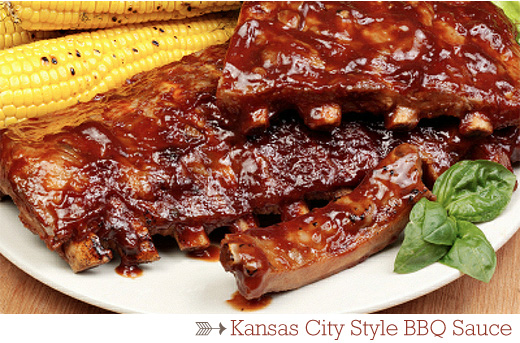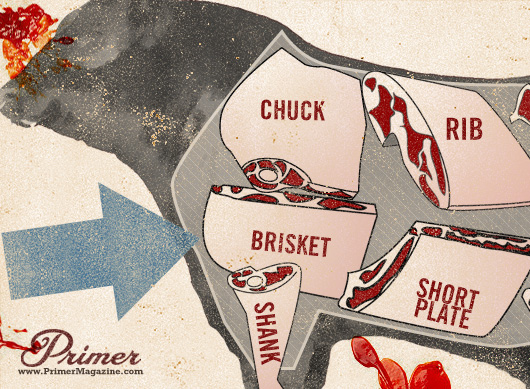Depending on where you’re from, barbecue can mean a number of things. Styles, techniques, recipes and definitions vary widely and there are stark divisions across the United States. Barbeque, as we know it in the US, is an icon as American as “amber waves of grain.” The fundamentals of barbecue, however, have existed since man first learned to control the sacred flame. Ultimately, barbecue boils down to cooking meat slowly over fire. Beyond that, leave it alone – it’s never wise to challenge what, for many, is an article of faith.
The spelling of the word and etymology is as ambiguous in American culture as the meaning. You can find evidence to trace ‘barbecue’, or ‘barbeque’, back to ‘barabicu’ from 16th century Spanish and English texts or you could point to more modern cowboy stories that are clever and believable. Barbeque is used to refer to a kind of food, an event, a flavor, a cooking process or even a piece of equipment. Dictionary.com reports that ‘barbecue’ can be a noun or a verb and lists 7 distinct meanings. The Marriam-Webster online dictionary defines ‘barbeque’ as a noun and ‘barbecue’ as a verb. Both sources, however, agree that the abbreviated ‘‘BBQ’’ means ‘barbecue’.
However the spelling, whatever the meaning, wherever it is served, BBQ is good. Whether buying meat, shopping for sauce or ordering at a restaurant, learning some basic barbeque terminology is an important step towards appreciating a truly classic culinary form.
BBQ Sauce
Countless recipes, unique to their region, have been adapted to accompany different meats and cooking methods. Most involve a few basic, base ingredients which include: tomato, vinegar, sweeteners (usually brown sugar or molasses), mustard, and sometimes even mayonnaise. Other flavors, usually specific to their area of origin, can include meat drippings, liquid smoke, Worcestershire, whiskey, peppers, herbs and spices. There are many philosophies on sauce mechanics but tomato and vinegar are frequently used in tandem.
Tomato based sauces are the most popular–tomato gives body and is a good canvas for building flavor and complexity. The most common styles are recognizable from restaurant menus and the condiment aisle at the grocery store. Many commercial brands toss around labels like “Hickory Style” and “Smokehouse” – these are generally some chemical variation of one of the following tomato-based styles. To quote the good folks at AmazingRibs.com, “If you pick up a bottle in the grocery and sugar or high fructose corn syrup are the first ingredients on the label, put it down.”
Kansas City Style BBQ sauce is very thick, sweet and sometimes spicy. Dark in color, it is usually sweetened with molasses or brown sugar and layered with flavors to no end.
Photo by Eatingtheroad
Memphis is revered for dry barbecue, which involves mostly spice rubs. Nevertheless, there are sauces labeled “Memphis Style”. They are tomato based, thinner than Kansas City, often tangy and somewhat sweet. St. Louis Style BBQ sauce is tomato and vinegar based, mildly spicy and slightly less sweet than Kansas City.
Photo by dennisandluba
Get your alchemy on, block out an hour or two and try this combination for a thick, sweet, spicy, tangy and complex sauce that is good for basting and dipping. This Cider-Beer BBQ sauce resembles Kansas City style but draws features from others:
In a saucepan, over low heat, start with 2 8-ounce cans of tomato sauce and add:
With each ingredient, start minimally, let simmer and add more as needed.
- 2 garlic cloves, crushed
- ¼ cup diced onion
- 2 TBSP whole grain mustard (or Dijon)
- ¼ cup cider vinegar
- ¼ cup dark beer
- 2 TBSP brown sugar
- 2 TBSP molasses (or honey)
- 1 TBSP Worcestershire
- Crushed red pepper flakes
- Cayenne pepper
- Fresh basil
- Salt and pepper to taste
Bubble gently and stir frequently until the desired consistency and balance is achieved.
Most will go their entire lives without ever encountering “White BBQ sauce” and, like some other specialized variations–it isn’t for everyone. Alabama Style (North Alabama, specifically) sauce is an unusual, and unlikely, contender in the barbeque world and the novelty of it alone is worth an honorable mention. This is mayonnaise based, balanced with vinegar, seasoned with black pepper and finished with any number of seasonings. Try it on pulled pork, as a dip or slather it on crispy, smoked chicken just before pulling it off the grill. Most Confederate states have at least one claim to fame in a worthy barbecue sauce style but their fame is too often limited to the region.
Photo by Foodbrood
In Texas, pit masters use rubs more than sauces since beef, usually beef brisket, carries the BBQ banner. Much of the Texas method involves smoke roasting over aromatic wood chips, like hickory or mesquite. Texas mop-sauces are generally light on the tomato and heavy on spices such as hot sauce, chili powder and ancho powder. They are bold, hard to sell bottled and “cool and moisten the meat during direct cooking” to produce a distinctive flavor.
Vinegar based sauces are widely used but not marketed like their tomato based adversary. When used with a tomato base, vinegar softens the texture of the sauce. A natural preservative, its gentle acidity breaks down fat and builds savor into meat. Vinegar sauces are thin, and harder to find packaged. They are typically used as a marinade or baste. As a marinade, vinegar will tenderize and penetrate meat, adding a tart and tasty dimension, before the cooking process. As a baste, it is mopped over meat while cooking. This will have the same effect as long as the cooking is “low and slow” (the poster child of BBQ method) — this way flavors have time to cut through and harmonize.
North Carolina has a distinct brand of barbeque and even within the state there are competing convictions. For the sake of concision, we won’t dive into the many nuances of Carolina BBQ. Eastern Carolina sauces are often very basic and are characterized by cider vinegar and hot pepper, not much else. Western Carolina sauces, while still vinegar based, tend to add a touch of tomato and slightly more brown sugar. Piedmont BBQ sauce is a sweeter style of Carolina BBQ (more sugar or molasses) and slightly thicker (more tomato or Worcestershire).
Meat
Sauce is just one pillar in the dogma that is barbecue. Ribs are are culmination of all things BBQ. Pork ribs are the most common, though it is not unusual to find beef ribs on a menu. Beef ribs are meatier, fattier and sometimes not as tender as their pork counterpart–more common in Texas barbecue. For many, pork ribs are the true meaning and purpose of barbecue.
Ribs are usually sold in “slabs”, anywhere from 11 to 14 ribs. They are identified as either spare ribs (side ribs) or back ribs, often called “loin back” ribs. Spare ribs are larger and meatier while back ribs are more tender, and cook faster. “Baby back ribs” are simply back ribs, with an enticing brand name.
Spare ribs include the breastbone. Rib tips (not to be confused with riblets, their trendy, rectangular shaped cousin) are breastbone trimmed off of spare ribs to create a flatter rack. What’s left after the trimming are “St. Louis Style” spare ribs. Take out even more of the hard bone and you have “Kansas City Style” spare ribs. Whatever the rib, always cook low and slow.
A barbeque menu without pulled pork might be driven to the trees with torches–regarded as a savage. “Boston Butt”, or pork shoulder, is cooked low and slow until the meat is tender enough to be easily pulled apart. The result is a mouth watering platter that can be enjoyed on its own, on a bun and with all manner of sauces and toppings. Coleslaw is at its best on pulled pork. The mayonnaise in good coleslaw adds enough tang and texture to enhance the rich flavors, while the cool crunch of shredded cabbage compliments the shredded form.
Photo by kamekame
Low and slow is integral in barbecue and that complicates its relationship with beef. Good cuts need a hot sear and short cooking time to lock in natural juices and maintain structure. Beef brisket is certainly not a good cut, but is the star of bovine barbecue and the pillar of Texas BBQ. Brisket is breast meat, the toughest part of the cow. The meat is mostly muscle, held together by collagen, which is connective tissue. When brisket is done properly the collagen slowly breaks down, marinating the meat while cooking in its own juices. A fork will move through a virtuous brisket like fingers through hair. It will fall apart.
There is more to barbecue than meat and sauce – grills, the cooking process, charcoal theory, it goes on. The history and complexity of what is, perhaps, the world’s oldest culinary art is vast. Meat and sauce are at the center in the context of American barbeque – basic knowledge of these is a healthy start to an honorable endeavor.























